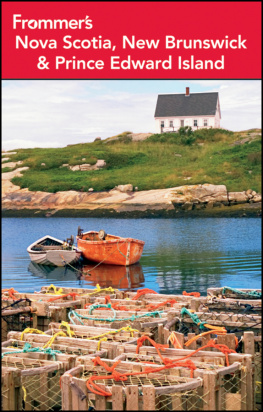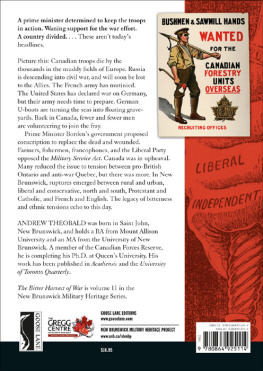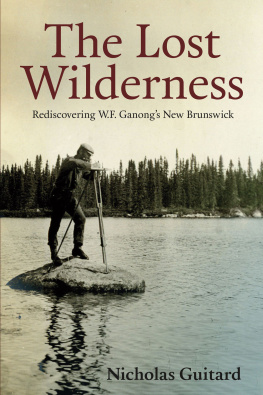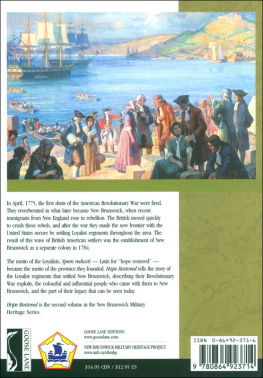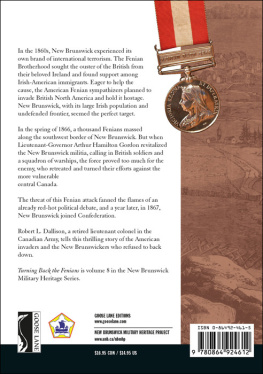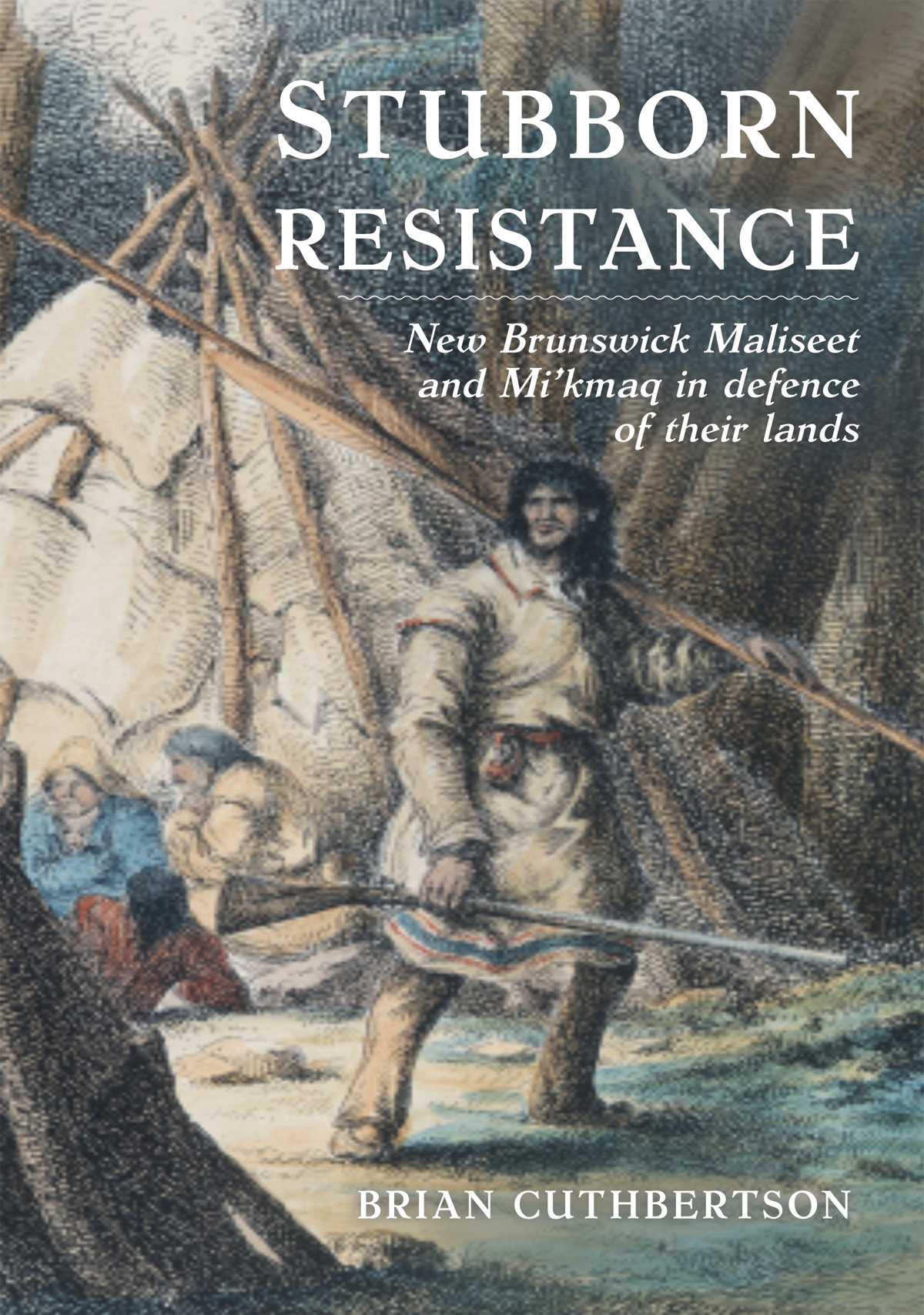Copyright
Copyright 2015, Brian Cuthbertson
All rights reserved. No part of this book may be reproduced, stored in a retrieval system or transmitted in any form or by any means without the prior written permission from the publisher, or, in the case of photocopying or other reprographic copying, permission from Access Copyright, 1 Yonge Street, Suite 1900, Toronto, Ontario M5E 1E5.
Nimbus Publishing Limited
3731 Mackintosh St, Halifax, NS B3K 5A5
(902) 455-4286 nimbus.ca
Printed and bound in Canada
NB1200
Cover photo: Lieutenant Robert Petley, 1837, Mikmaw hunter with fish, spear, musket, and paddle, coloured lithograph. Library Archives Canada, C-023349
Design: Peggy & Co. Design, Halifax
Library and Archives Canada Cataloguing in Publication
Cuthbertson, Brian, 1936-, author
Stubborn resistance : New Brunswick Maliseet and Mikmaq in defence of their lands / Brian Cuthbertson.
Includes bibliographical references and index.
Issued in print and electronic formats.
ISBN 978-1-77108-346-1 (paperback).ISBN 978-1-77108-347-8 (html)
1. Malecite IndiansLand tenureNew BrunswickHistory19th century. 2. Micmac IndiansLand tenureNew BrunswickHistory19th century. 3. Malecite IndiansNew BrunswickGovernment relationsHistory19th century. 4. Micmac IndiansNew BrunswickGovernment relationsHistory19th century. 5. Land tenureGovernment policyNew BrunswickHistory19th century. 6. New BrunswickRace relationsHistory19th century. I. Title.
E99.M195C88 2015 971.510049734 C2015-904337-9
C2015-904338-7
Nimbus Publishing acknowledges the financial support for its publishing activities from the Government of Canada through the Canada Book Fund (CBF) and the Canada Council for the Arts, and from the Province of Nova Scotia. We are pleased to work in partnership with the Province of Nova Scotia to develop and promote our creative industries for the benefit of all Nova Scotians.
Foreword
A s a Maliseet woman, a teacher, a lawyer, a chief, and a mother, I cannot overstate the importance of learning about our past. The Mikmaq and Wolastoqiyik have struggled to maintain their traditional lands since the first arrival of European immigrants. Even those who participated in this so-called settlement of the New World have recognized this struggle, or resistance, to our homeland encroachment. Today this resistance continues and is evident through the many specific land claims, comprehensive claims, grassroots and leadership protests, as well as in the Canadian court system. Brians book is a shining example of how we can begin to understand the daily details of this struggle in those days when New Brunswick was becoming a province.
I first had the pleasure of working with Brian when I worked for the federal government in the Specific Claims Branch of Aboriginal and Northern Affairs Canada. Brians analytic skills and attention to detail made him the perfect historian for joint research projects between the Government of Canada and First Nations. Currently, Brian is also working with the Madawaska Maliseet First Nation as an expert witness in their specific claim, which is now at the Specific Claims Tribunal.
Much has been written about historical federal Indian legislation, but little about how colonial and provincial legislation discriminated against First Nations in this country. Brians detailed accounts about New Brunswicks discriminatory 1844 act and its purpose to eliminate our homelands demonstrate not only the thinking of the time, but also how non-Aboriginal leaders saw how this was wrong and unfair to First Nations in the province. In a time when settlement of the colony was vital to many politicians, there were some who understood that this land was never sold, nor ceded, nor obtained by conquest, and that the Indians were the rightful possessors and Lords of the soil.
Stubborn Resistance is important because it illustrates that First Nations people in New Brunswick have not only recently begun to speak out, but have been doing so since before the creation of the province. Brians dedication and hard work in hunting down primary documents and piecing them together is extremely helpful for those looking to better understand the foundations of the frustrations faced by todays Mikmaq and Wolastoqiyik.
Chief Patricia Bernard
Madawaska Maliseet First Nation
July 2015
Preface
M y purpose in writing this book is to tell the story of New Brunswicks Maliseet and Mikmaw resistance to the loss of lands that had been set aside in good faith as reserves for them. The story begins with the twenty thousand acres Chief John Julian of the North West Miramichi River Tribe received for his loyalty to George III during the American Revolution. It ends in 1974 with the Department of Indian Affairs decision to remove squatters from the Red Bank Reserve on the Little South West Miramichi River instead of insisting on a surrender of the reserve lands for sale to the squatters. The story has contemporary relevance because of the dramatically changing relationship between First Nations and Canada as reflected in the ongoing negotiations over such issues as environmental concerns, education, and governance. Although the paternalistic role of Indian Affairs that so dominated in the past has dramatically changed, I hope the story, as I tell it, reminds our generation that much of present attitudes have historical roots that cannot be ignored.
In the case of New Brunswick, the past is still very much with us because of the 1844 Act to Regulate the Management and Disposal of the Indian Reserves. The act gave the government of the day the legislative authority to auction reserve lands, regardless of opposition by the Maliseet and Mikmaq, who had been occupying these lands for generations. The method chosen was to sell by public auction lots of reserve lands occupied by squatters and other reserve lands, which could then be opened to settlement by non-Aboriginals. The money raised by sales was to create an Indian Fund for their permanent betterment. As I describe it, the act failed on both accounts: as a means of improving the livelihood of the Maliseet and the Mikmaq and of dealing with the squatters who, with few exceptions, refused to purchase the lots they illegally occupied. As a result, the substantial funds predicted by the government for the Indian Fund never materialized, the Maliseet and Mikmaq still on the reserves received no financial benefit from the sales made, and they also lost the lands occupied by squatters.
Even at the time the 1844 act was passed, there were doubts whether the government could sell reserve lands. It is an open question today, in the context of more recent court decisions favourable to Aboriginal peoples, whether the 1844 act could be challenged. Between 1849 and 1867, under the authority of the 1844 act, the government put 20,456 acres up for auction that were lost to eleven New Brunswick reserves of the time. Most of these reserves still exist. If a court challenge proved successful, the compensation could be in the tens of millions of dollars.
The genesis of this book derives from a series of reports that I researched and prepared for the New Brunswick First Nations of Red Bank (now Metepenagiag), Buctouche, and Tobique. Copies of these reports, with their indexed documentation in bound volumes, have been deposited with the Provincial Archives of New Brunswick in Fredericton.
The objective was to submit these reports for Red Bank, Buctouche, and Tobique under the specific claims policy of the Department of Indian Affairs (now Department of Aboriginal Affairs and Northern Development Canada). Generally, the term


